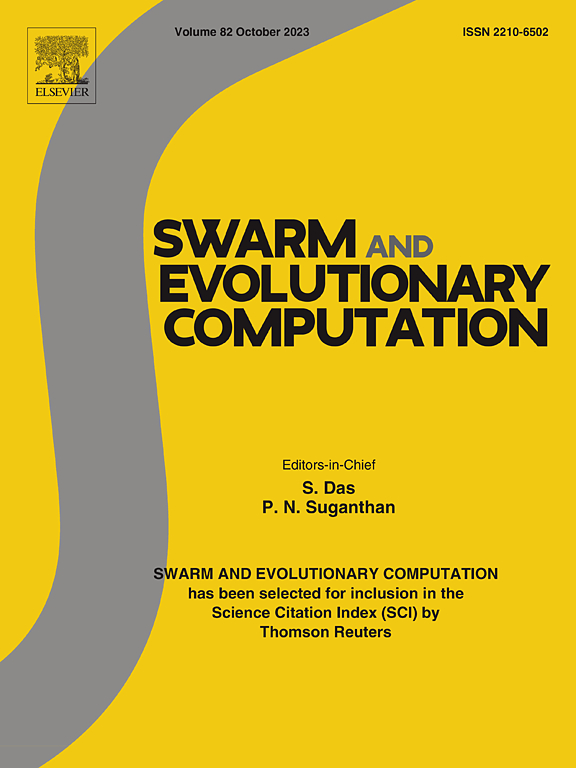GEFS-AO: A novel graph-based evolutionary feature selection method from the view of auxiliary optimization
IF 8.2
1区 计算机科学
Q1 COMPUTER SCIENCE, ARTIFICIAL INTELLIGENCE
引用次数: 0
Abstract
Graph-based evolutionary feature selection (FS) algorithms attract much attention, since they can simultaneously utilize the advantages of graph and evolutionary computation for solving FS problem. Despite that, due to the encoding of evolutionary algorithms, they often need to search in a complex and large feature graph space. To this end, these algorithms develop different evolutionary operators to overcome the challenge. Unlike the existing algorithms that directly deal with complex optimization problem, this paper tackles the problem from the perspective of auxiliary optimization, where the original complex optimization problem is decomposed into two simple yet complementary auxiliary optimization subproblems. Specifically, in the proposed algorithm (GEFS-AO), a fully connected feature graph is firstly constructed, from which two simple auxiliary feature subgraphs are created. One subgraph only uses some important nodes (features) and all their edges, which ensures the latent important feature combinations could be detected. Another subgraph uses all the nodes and each node only has one edge, which guarantees all features are considered. On each subgraph, a population is evolved to obtain its feature subsets, which is viewed as one auxiliary optimization subproblem. During the evolution, a pair of information exchanging strategies is designed between two auxiliary optimizations, which can adjust the structures of two auxiliary subproblems and improve the performance of both auxiliary optimization subproblems. Moreover, a node weight update strategy is also suggested for two auxiliary subgraphs, which further enhances the quality of final feature subsets. Experimental results on different FS datasets demonstrate the effectiveness of the proposed GEFS-AO.
GEFS-AO:一种从辅助优化角度出发的基于图的进化特征选择方法
基于图的进化特征选择(FS)算法由于能够同时利用图和进化计算的优点来求解进化特征选择问题而备受关注。尽管如此,由于进化算法的编码,它们往往需要在一个复杂而庞大的特征图空间中进行搜索。为此,这些算法开发了不同的进化算子来克服这一挑战。与现有算法直接处理复杂优化问题不同,本文从辅助优化的角度来解决问题,将原来的复杂优化问题分解为两个简单但互补的辅助优化子问题。具体而言,该算法首先构造一个全连通特征图,并在此基础上创建两个简单的辅助特征子图。一个子图只使用一些重要的节点(特征)及其所有的边,保证了潜在的重要特征组合可以被检测到。另一个子图使用所有的节点,每个节点只有一条边,这保证了所有的特征都被考虑在内。在每个子图上,进化一个种群以获得其特征子集,这被视为一个辅助优化子问题。在演化过程中,设计了一对辅助优化之间的信息交换策略,可以调整辅助子问题的结构,提高辅助优化子问题的性能。此外,还针对两个辅助子图提出了节点权值更新策略,进一步提高了最终特征子集的质量。在不同FS数据集上的实验结果验证了该方法的有效性。
本文章由计算机程序翻译,如有差异,请以英文原文为准。
求助全文
约1分钟内获得全文
求助全文
来源期刊

Swarm and Evolutionary Computation
COMPUTER SCIENCE, ARTIFICIAL INTELLIGENCEC-COMPUTER SCIENCE, THEORY & METHODS
CiteScore
16.00
自引率
12.00%
发文量
169
期刊介绍:
Swarm and Evolutionary Computation is a pioneering peer-reviewed journal focused on the latest research and advancements in nature-inspired intelligent computation using swarm and evolutionary algorithms. It covers theoretical, experimental, and practical aspects of these paradigms and their hybrids, promoting interdisciplinary research. The journal prioritizes the publication of high-quality, original articles that push the boundaries of evolutionary computation and swarm intelligence. Additionally, it welcomes survey papers on current topics and novel applications. Topics of interest include but are not limited to: Genetic Algorithms, and Genetic Programming, Evolution Strategies, and Evolutionary Programming, Differential Evolution, Artificial Immune Systems, Particle Swarms, Ant Colony, Bacterial Foraging, Artificial Bees, Fireflies Algorithm, Harmony Search, Artificial Life, Digital Organisms, Estimation of Distribution Algorithms, Stochastic Diffusion Search, Quantum Computing, Nano Computing, Membrane Computing, Human-centric Computing, Hybridization of Algorithms, Memetic Computing, Autonomic Computing, Self-organizing systems, Combinatorial, Discrete, Binary, Constrained, Multi-objective, Multi-modal, Dynamic, and Large-scale Optimization.
 求助内容:
求助内容: 应助结果提醒方式:
应助结果提醒方式:


